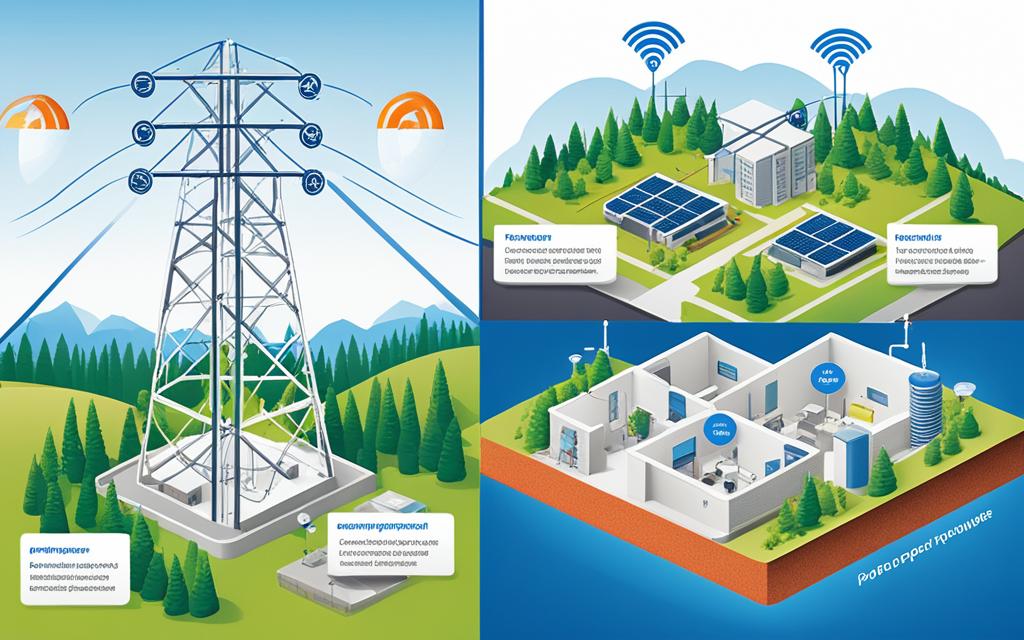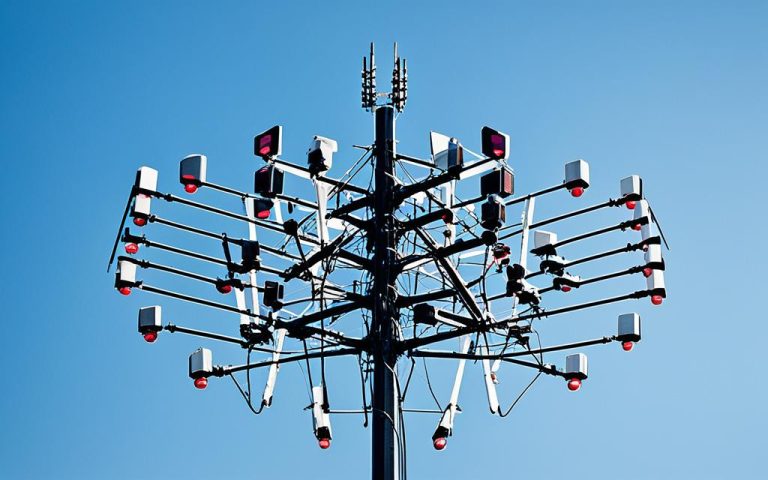Point-to-Multipoint (P2MP) networks are a crucial aspect of fixed wireless systems, offering efficient and scalable connectivity. These networks, commonly used in wireless internet and IP telephony applications, provide multiple paths from a single location to multiple locations, ensuring reliable and low-latency connectivity. In comparison to Point-to-Point (PTP) configurations, P2MP networks excel at delivering small data packets to multiple users or locations.
In this article, we will explore the key features and benefits of Point-to-Multipoint networks in fixed wireless systems, shedding light on the differences between P2MP and PTP microwave configurations. By understanding these concepts, businesses and organizations can make informed decisions regarding their connectivity requirements.
Let’s delve into the world of Point-to-Multipoint networks and discover how they enhance connectivity in fixed wireless systems.
Point-to-Point Microwave (PTP)
Point-to-Point (PTP) microwave communication configurations are designed to establish a secure, high-speed, and uninterrupted connection between two communication devices, namely a transmitter and a receiver. These configurations are a fundamental component of microwave communication, specifically tailored for situations where data transmission predominantly occurs between two specific locations.
The cornerstone of PTP microwave radios lies in the principle of line of sight communication, where an unobstructed, direct path between the transmitter and receiver is essential for optimal connection quality. By minimizing obstacles and maximizing signal strength, line of sight ensures a robust and reliable microwave link. This configuration is commonly employed in scenarios where point-to-point data transmission is paramount, offering a tailored solution for organizations seeking efficient and direct communication.
“PTP microwave communication configurations serve as a secure, high-speed, and uninterrupted conduit between two points, empowering organizations to transmit data swiftly and reliably.”
The Benefits of Point-to-Point Microwave (PTP)
Point-to-Point microwave communication offers several advantages that make it a versatile and effective solution for targeted data transmission:
- Rapid and secure connectivity between two points
- Low latency and high bandwidth capabilities
- Robust signal transmission, particularly in remote or challenging environments
- Enhanced reliability and integrity of data transmission
- Mitigation of potential interference or network congestion
With its focus on direct, point-to-point communication, PTP microwave configurations ensure that critical data is delivered swiftly and efficiently, making it an ideal choice for organizations that prioritize high-speed, secure, and uninterrupted communication between specific locations.
| Advantages of Point-to-Point Microwave (PTP) | Disadvantages of Point-to-Point Microwave (PTP) |
|---|---|
| Secure and fast communication | Requires a direct line of sight between the transmitter and receiver |
| Minimal latency and high bandwidth capabilities | Installation costs can be higher compared to other communication methods |
| Reliable signal transmission, particularly in remote locations | Link distance limitations based on available power and fading |
Note: The table above summarizes the advantages and disadvantages of Point-to-Point microwave communication.
Overall, Point-to-Point microwave communication configurations provide organizations with a tailored solution for establishing secure, high-speed, and direct communication between two specific points. By leveraging the inherent benefits of line of sight communication, PTP microwave configurations deliver reliable connectivity that is essential for efficient data transmission in the digital age.
Point-to-Multipoint Microwave (PTMP)
Point-to-Multipoint (PTMP) microwave communication configurations are an efficient way to transmit data from a single transmitter to multiple receivers. Unlike Point-to-Point (PTP) setups, PTMP involves a broadcast network where each receiver connects to the single transmitter individually. This configuration is ideal for delivering small amounts of data to multiple locations or users.
In a PTMP network, the channel capacity is shared between the connected receivers, allowing for simultaneous data transmission to multiple locations. Each receiver determines if the information is intended for it or not, enhancing data privacy and security. This flexibility makes PTMP connections suitable for situations where a single transmitter sends bursts of data to multiple locations, regardless of their physical proximity.
PTMP microwave communication is widely used in various applications, including wireless internet and IP telephony. It offers benefits such as low latency, high reliability, and the ability to reach multiple locations without the need for a direct connection between them.
| Configuration Type | Advantages | Disadvantages |
|---|---|---|
| Point-to-Multipoint (PTMP) |
|
|
Key Differences Between Point-to-Point and Point-to-Multipoint Microwaves
When it comes to microwave configurations, there are key differences between Point-to-Point (PTP) and Point-to-Multipoint (PTMP) setups. Understanding these distinctions is essential for businesses and organizations looking to optimize their wireless connectivity. Let’s explore the significant variances:
Transmitter and Receiver Configuration:
In Point-to-Point (PTP) microwave setups, there is a single transmitter and receiver, creating a direct connection between two points. On the other hand, Point-to-Multipoint (PTMP) microwave configurations involve a single transmitter and multiple receivers, allowing for communication with multiple points simultaneously.
Channel Capacity:
PTP configurations reserve the entire channel capacity for data transfer between the two points. This ensures a dedicated and secure connection for high-speed transmission of large data volumes. In contrast, PTMP configurations share the channel capacity among multiple receivers, enabling the delivery of small data packets to multiple users or locations simultaneously.
Line of Sight Requirement:
PTP microwave setups require a direct line of sight between the transmitter and receiver for optimal signal quality and performance. In contrast, PTMP configurations only require line of sight between the transmitter and each receiver. This flexibility allows for greater freedom in deploying microwave systems, as receivers do not need to be in close proximity to each other.
Transmission Type:
PTP configurations excel in one-way, high-speed transmission scenarios where large amounts of data need to be sent between two points. They are ideal for applications that demand secure data transfer and real-time communication. PTMP microwaves, on the other hand, are best suited for delivering small data packets to multiple users or locations. This makes them a great choice for broadcasting information to a wide audience efficiently.
Understanding these key differences between Point-to-Point (PTP) and Point-to-Multipoint (PTMP) microwave configurations is crucial for businesses and organizations seeking the right wireless connectivity solution. By taking into account the specific requirements of their use case, they can make informed decisions about which configuration best suits their needs.

| Point-to-Point (PTP) | Point-to-Multipoint (PTMP) |
|---|---|
| A single transmitter and receiver | A single transmitter and multiple receivers |
| Reserved channel capacity for data transfer between two points | Shared channel capacity among multiple receivers |
| Requires line of sight between transmitter and receiver | Requires line of sight between transmitter and each receiver |
| Best for one-way, high-speed transmission of large amounts of data | Ideal for delivering small data packets to multiple users or locations |
Modern Point-to-Multipoint Wireless Communications
In modern usage, Point-to-Multipoint (P2MP) wireless communications are widely employed for fixed wireless data communications, facilitating internet or voice over IP connectivity through radio or microwave frequencies in the gigahertz range. P2MP networks are the preferred approach for wireless data communications that involve a large number of nodes or end users. These networks typically consist of a central base station which acts as the hub, connecting remote subscriber units or customer premises equipment (CPE) at different locations.
The connections between the base station and subscriber units can vary between line-of-sight and non-line-of-sight, depending on the specific frequency employed in the system. Lower frequencies allow for non-line-of-sight connections, which can expand the coverage area and increase connectivity options for a greater number of CPEs. This flexibility makes P2MP wireless communications an ideal solution for providing connectivity to remote or geographically dispersed locations.
With the ability to deliver reliable wireless data communications, P2MP networks offer several advantages:
- Scalability: P2MP networks can easily accommodate a large number of nodes or end users, making them suitable for applications with high traffic demands.
- Efficiency: By utilizing a central base station, P2MP networks allow for efficient transmission and reception of data to multiple locations simultaneously, reducing resource consumption and improving overall network performance.
- Reliability: P2MP networks provide reliable connectivity, ensuring consistent data transmission and minimizing downtime.
- Flexibility: The ability to establish both line-of-sight and non-line-of-sight connections allows for greater adaptability to different geographical and environmental conditions.
With advancements in technology, modern P2MP wireless communications systems have leveraged gigahertz frequencies to enable high-speed data transfers and support bandwidth-intensive applications. These systems efficiently transmit data packets to multiple users, ensuring seamless wireless connectivity for various purposes, including internet access, voice over IP, and data exchange.
By harnessing the power of modern P2MP wireless communications, businesses and individuals can enjoy fast and reliable wireless data connectivity, enabling them to stay connected and productive in the digital age.
Point-to-Multipoint Wireless Network Challenges
Point-to-Multipoint (P2MP) wireless networks using directional antennas face several challenges, one of which is the hidden node problem. This problem arises when using CSMA/CA (Carrier Sense Multiple Access with Collision Avoidance) protocols, as directional antennas may not detect each other’s transmissions. To overcome this issue, P2MP networks can employ alternative protocols such as time-division multiple access (TDMA) or polling.
The hidden node problem poses a significant obstacle to the effective operation of P2MP networks, as it can lead to collisions and data loss. By utilizing TDMA or polling protocols, network administrators can optimize communication timings and ensure prioritization and scheduling of transmissions to avoid collisions.
The Hidden Node Problem
The hidden node problem refers to a situation wherein two or more devices are unable to detect each other’s transmissions due to the use of directional antennas. This results in a loss of synchronization and can lead to collisions in the network. In P2MP networks, directional antennas are commonly used to establish connections between a central base station and multiple remote subscriber units or customer premises equipment (CPE).
“The hidden node problem is a common challenge faced by point-to-multipoint wireless networks.”
Directional antennas are designed to focus the energy of the transmitted signal in a specific direction, improving link quality and reducing interference. However, this directional transmission also poses a challenge when multiple directional antennas are utilized within the same network. Each antenna may only detect signals within its specific coverage area, resulting in an inability to sense transmissions from other nodes outside its range. Consequently, collisions can occur when two or more nodes transmit simultaneously, leading to packet loss and degraded network performance.
Overcoming the Hidden Node Problem
One approach to mitigate the hidden node problem in P2MP networks utilizing directional antennas is by replacing CSMA/CA protocols with TDMA or polling protocols. These alternative protocols offer improved control over communication timings and help avoid collisions.
“Employing TDMA or polling protocols can effectively address the hidden node problem in P2MP wireless networks.”
Time-division multiple access (TDMA) involves dividing the available time into time slots, with each node assigned a specific slot for transmitting data. This ensures that transmission timings are coordinated, minimizing the likelihood of collisions between nodes. With TDMA, each node has exclusive access to the channel at a predetermined time, preventing interference and collisions with other nodes. This protocol offers efficient utilization of network resources and excellent throughput.
Polling protocols, on the other hand, operate by enabling the central base station to control the transmissions of each remote subscriber unit or CPE. The base station polls each node in the network and grants permission for transmission according to a predefined schedule. By centralizing the control of transmissions, polling protocols effectively manage and prioritize communication, minimizing collisions and improving overall network performance.
By adopting TDMA or polling protocols, P2MP wireless networks using directional antennas can overcome the hidden node problem and ensure efficient and reliable communication between the base station and remote nodes.
Frequency Bands and Base Station Configurations
Point-to-Multipoint (P2MP) systems can operate in various frequency bands, depending on the specific application. These frequency bands can be categorized as licensed, semi-licensed, or unlicensed, each offering different advantages and regulatory considerations. Licensed frequency bands provide exclusive access to specific operators and typically offer higher power levels, ensuring a more reliable and interference-free connection. Semi-licensed frequency bands combine elements of licensed and unlicensed bands, requiring operators to adhere to certain guidelines while offering more flexibility than licensed bands. Unlicensed frequency bands, on the other hand, are open for public use and allow for more access points, but may be susceptible to interference from other devices operating in the same band.
The base station in a P2MP system can be configured with either a single omnidirectional antenna or multiple sector antennas. The choice of antenna configuration depends on factors such as coverage area, signal quality, and capacity requirements. A single omnidirectional antenna provides equal signal distribution in all directions, making it suitable for small-scale deployments or applications where coverage area is not a primary concern. On the other hand, multiple sector antennas offer increased range and capacity by providing focused coverage in specific directions or sectors. This configuration is commonly used in large-scale networks or deployments with high-density user environments.
P2MP systems also employ different duplexing techniques, such as frequency-division duplexing (FDD) and time-division duplex (TDD). FDD systems use separate frequency bands for uplink and downlink transmissions, enabling full-duplex connections. This allows simultaneous two-way communication between the base station and subscriber units. TDD systems, on the other hand, allocate time slots within the same frequency band for uplink and downlink transmissions, offering half-duplex connections. While TDD systems do not provide simultaneous two-way communication, they offer greater flexibility in adjusting the uplink and downlink ratio to accommodate varying traffic demands.
| FDD Systems | TDD Systems |
|---|---|
| Full-duplex connections | Half-duplex connections |
| Separate frequency bands for uplink and downlink | Time slots within the same frequency band for uplink and downlink |
| Suitable for applications requiring simultaneous two-way communication | Flexible uplink and downlink ratio adjustments to accommodate varying traffic demands |
Conclusion
Point-to-Multipoint (P2MP) networks are an essential component of modern fixed wireless systems, offering efficient and scalable connectivity. These networks provide numerous advantages, including high reliability, low latency, and shared channel capacity. P2MP configurations are particularly well-suited for delivering small data packets to multiple users or locations, making them ideal for applications such as wireless internet and IP telephony.
By understanding the differences between Point-to-Point (PTP) and Point-to-Multipoint (PTMP) microwave configurations, businesses and organizations can make informed decisions regarding their internet connectivity needs. PTP networks excel in delivering high-speed data between two points, while PTMP networks shine in broadcasting small packets of data to multiple users.
In the digital age, where connectivity is crucial, P2MP networks offer flexible solutions for various connectivity requirements. Whether it’s establishing reliable connections between multiple locations or enabling seamless communication with numerous users, P2MP networks play a vital role in ensuring uninterrupted connectivity in fixed wireless systems.
FAQ
What are Point-to-Multipoint (P2MP) networks?
Point-to-Multipoint (P2MP) networks are a type of microwave radio communication configuration used in fixed wireless systems. They offer multiple paths from a single location to multiple locations, allowing for efficient and scalable connectivity.
What are the key differences between Point-to-Point (PTP) and Point-to-Multipoint (PTMP) microwave configurations?
The key differences between Point-to-Point (PTP) and Point-to-Multipoint (PTMP) microwave configurations are as follows:
– PTP configurations involve a single transmitter and receiver, while PTMP configurations have a single transmitter and multiple receivers.
– In PTP, the entire channel capacity is reserved for data transfer between two points, while in PTMP, the channel capacity is shared between multiple receivers.
– PTP requires line of sight between the transmitter and receiver, while PTMP only requires line of sight between the transmitter and each receiver.
– PTP is best for one-way, high-speed transmission of large amounts of data, while PTMP is ideal for delivering small data packets to multiple users or locations.
How do Point-to-Multipoint (P2MP) networks operate in fixed wireless systems?
Point-to-Multipoint (P2MP) wireless communications refer to fixed wireless data communications for internet or voice over IP using radio or microwave frequencies in the gigahertz range. P2MP networks typically involve a central base station to which remote subscriber units or customer premises equipment (CPE) are connected. The connections between the base station and subscriber units can be line-of-sight or non-line-of-sight, depending on the system’s frequency.
What challenges do Point-to-Multipoint (P2MP) networks using directional antennas face?
Point-to-Multipoint (P2MP) systems using directional antennas face challenges, including the hidden node problem. This problem occurs when CSMA/CA (Carrier Sense Multiple Access with Collision Avoidance) protocols are used, as the directional antennas may not detect each other’s transmissions. To mitigate this issue, P2MP networks can employ time-division multiple access (TDMA) or polling protocols instead of CSMA/CA.
What frequency bands can Point-to-Multipoint (P2MP) systems operate in?
Point-to-Multipoint (P2MP) systems can operate in licensed, semi-licensed, or unlicensed frequency bands, depending on the specific application. The base station can have a single omnidirectional antenna or multiple sector antennas. Multiple sector antennas allow for greater range and capacity, as they provide coverage in different directions. P2MP systems using frequency-division duplexing (FDD) offer full-duplex connections, while time-division duplex (TDD) systems offer half-duplex connections.




















One Comment